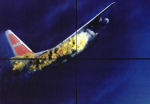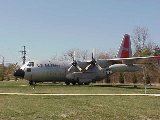

 |
 |
When Rocky asked me to speak to the group today, I was both touched by the gesture, and befuddled as to what I would talk about. As you know, we all share common threads, including our work as airborne Vietnamese linguists, our Air Force heritage, and our having been so disappointed at the timing of the disengagement of the U.S. government from the war in Vietnam, and the fall of Saigon which quickly followed.
Many of us felt that disengagement zeroed out the efforts of almost a decade for some of us, and significant portions of our Air Force time for all of us. Many in our generation can remember exactly where we were and what we were doing when president Kennedy was assassinated in 1963, and when astronaut Neil Armstrong made his "One small step" on the moon on july 20, 1969.
One of the things that defines this group however, is that we can remember where we were, what we were doing, and how we felt on the day and hour when saigon fell to communist rule on april 30th, 1975. Not many other Americans can remember the event as clearly. It binds this group even more tightly together based on the nature of our work at the time, and the professionalism and effort each of us and our contemporaries put into our work in support of that war effort.
For my part, I had left the USAF in 1970, returned to Washington D.C. to attend George Washington university, and had hired on with the organization across the parking lot from this memorial in early 1973 as a Vietnamese language intern. My fortunes turned in another direction as i was retrained in Korean in 1973 and moved off to Seoul Korea in 1974 to attend Yonsei University's Korean language institute. It was there, on april 30th 1975 that I listened to then president Pak Chung-Hee's address to the Korean people on that fateful day. Knowing what I Knew about the history of US-ROK relations, I was disappointed, but not surprised, at what he told the Korean people. My recollection is that he spoke about Korea's inability to rely any more on a great power's protection, and urged renewed self reliance on the part of the ROK military so that their alliance with the United States would never place them in a similar predicament to the South Vietnamese government, which had counted on the us to be there all the way, and been abandoned at the last.
Disappointed as i was, and i know you all were, about the outcome of the Vietnam conflict, i was doubly disappointed at president Pak's portrayal of our government as one without the staying power to complete the task at hand. Hearing his words, i resolved that, given a similar chance in the future, i would do everything in my power to insure that my own efforts and those of folks who might work for me would be 100 percent dedicated to the success of us armed forces and our future allies, such that we would do our absolute best to assure success.
The effort in which we all engaged in the 60's and early 70's, in the Vietnamese experience, and for those of us who have had similar additional engagements, in the Persian Gulf among other places, acted both as a bonding agent and a preparation for future engagements, which i am happy to report, have completed more favorably for the us and its allies. Experiences like ours are irreplaceable in building the capabilities of succeeding generations to perform the art we call signals intelligence at a level of excellence unmatched elsewhere.
And so, once a year we get together to tell war stories, celebrate our victories (and there were many in that era i spoke of, despite its less than desirable end), and remember those of our profession who cannot be here with us, having been unable to make the trip, or more sadly, gone on to their final debriefing, those numbers increasing year by year.
Remembrance is important, both for its catharsis for those who tell the stories, but also for instructive purposes for those who hear them. Remembrance reminds us that we stand on the shoulders of those who came before us, and in the same manner, the younger generations stand on our own shoulders as they continue to perform the functions we performed, albeit with better technology, in pursuit of supporting our world class military in furtherance of the interests of the nation we all love.
So, it is fitting that we have this gathering here, at vigilance park, and tomorrow's gathering at the wall, to pay our respects to those like us, who have gone before, and especially to those who have departed the scene much too early, while doing the things we did.
This vigilance park came about through the efforts of a number of individuals and organizations whose desires coincided in space and time to make it happen. Several of the prime movers in its creation included Lieutenant General Ken Minihan, then director of NSA, SMSgt Retired larry tart, author of the price of vigilance, Col Chris Cooke, then assigned to the nsa and commander of the 694th intelligence squadron, and hundreds of others too numerous to mention.
Lieutenant General Minihan, having previously been commander of the Air Force Intelligence Center, as the United States Air Force Security Service we served had come to be called at the time (circa 1996), had successfully established a similar memorial on Security Hill at Kelly Air Force Base in Texas, emplacing an ec-47 of the type lost on two occasions during the Vietnam conflict as a salute to AIA's cold war efforts.
At the time of general Minihan's directorship, i was NSA's director of policy, and charged with a number of responsibilities revolving around classification policy, freedom of information and privacy act determinations, and public affairs. Following this ceremony, those who wish to do so may tour the National Cryptologic Museum. the museum opened in late 1993, and represents the first and only intelligence community museum situated in a location allowing public access.
When Lieutenant General Minihan arrived at NSA, in my first meeting with him, he wanted to know why we did not have an airplane in our parking lot, celebrating the successful efforts of airborne signals intelligence in ending the cold war. I told the general that the existence of such a memorial on NSA property would represent a de facto revelation of the fact of signals intelligence from aircraft; a fact that had never been declassified by the United States government, despite previous incidents and public disclosures (not declassifications) surrounding them. Suffice it to say that i got marching orders to "make it so," and we set about to do that, with all the national level coordinations required.
At the same time, Larry Tart's book was in preparation via a number of FOIA review requests, a process all agreed took longer than it should on every case, but nevertheless a process we were charged to execute by the numbers by national direction. Also concurrently, work was underway to document the various incidents and shootdowns including reconnaissance platforms beyond the SIGINT envelope to include imagery and others. The then 694th intelligence group here at NSA became engaged in the process as well, and did most of the heavy lifting with the USAF. I will skip over the detail, but in the end, thanks to the efforts of hundreds of folks at NSA and HQ USAF, agreement was reached to place an RC-130A on this site to commemorate the loss of 17 airmen (11 security service, and 6 flight crew) on 2 september 1958 in the waters off Soviet Armenia when two russian mig-17 fighters shot C-130 60528 down while on a maiden flight near Yerevan, killing the entire crew.
Major General Mike Hayden, then commander of Air Intelligence Agency, signed the official papers taking receivership of this airframe from Davis Monthan AFB.
Raytheon E-systems, Greenville Texas, provided the paint job, an extremely involved process done at Raytheon's expense several times to get it just right, and a volunteer crew from Eglin AFB, FL, flew the stripped-down aircraft from Greenville to Tipton field, a mile from here, under visual flight rules with a single VHF radio and a hand held GPS unit for navigation. Once here, USAF and Air National Guard Technicians with support of NSA volunteers, and NSA and Fort Meade Police, disassembled the major portions of the bird, trucked it to this site, and reassembled it in a USAF standard display stand, as you can see here.
As a related matter, USAF HQ agreed that the families of the fallen crew should receive posthumous Air Medals, and learn, for the first time, the mission their loved ones were engaged in when shot down. The ceremony, held on this spot on september 2, 1997, the 39th anniversary of that day, was attended by family members of most of the deceased crew members, and was marked in so far as we know, by the only missing man formation by C-130 aircraft, as a final salute to those crewmembers. If you are able to accompany the museum interpreters on the tour in a few minutes, you will have a chance to see some of the memorabilia provided by the families for those displays. Within a few short years, the RC-130 was joined by a US Army RU-8, and a US Navy EA-3B, providing salutes to those among our bretheren in navy blue and green who also gave all in efforts similar to ours. Later, a plaque was added here, commemorating each airframe type, 13 in all, represented by those cypress trees behind the c-130, that up to that time had been involved either in a shootdown or a fatal crash of a reconnaissance mission aircraft.
So, to bring this home, gatherings like ours are important for a host of reasons, not the least of which is that they provide us all opportunities to see and interact with each other... while we are still able to do so. They are about remembrance, telling the stories, and celebrating those who are not, or could not be here. Many of you are here for the first time, some have been here before. it is fitting that we, who shared a profession with the crew of 60528 gather on this spot to relate to "our" experiences while honoring theirs. For in some sense, we gather "for" the men aboard 60528 that fateful day, who in an instant, lost the opportunity to do as we are able to do today and tomorrow, year on year. On Rocky and Joe Turney's behalf, i welcome all of you here, thank you for making the trip, and invite you to join us for tours of the National Cryptologic Museum immediately following this gathering.
-- Jim Cavanaugh